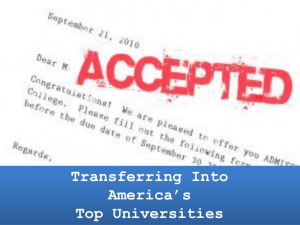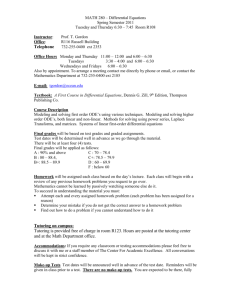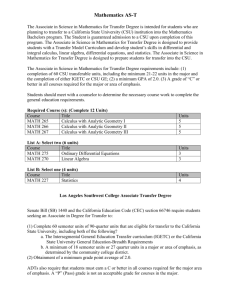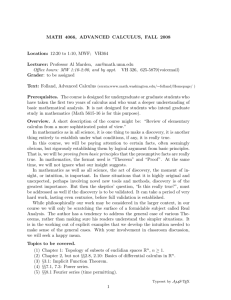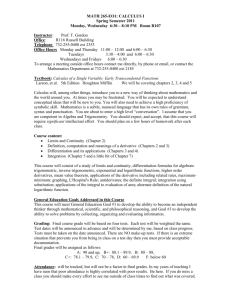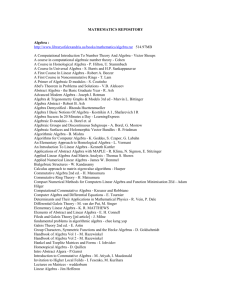advertisement
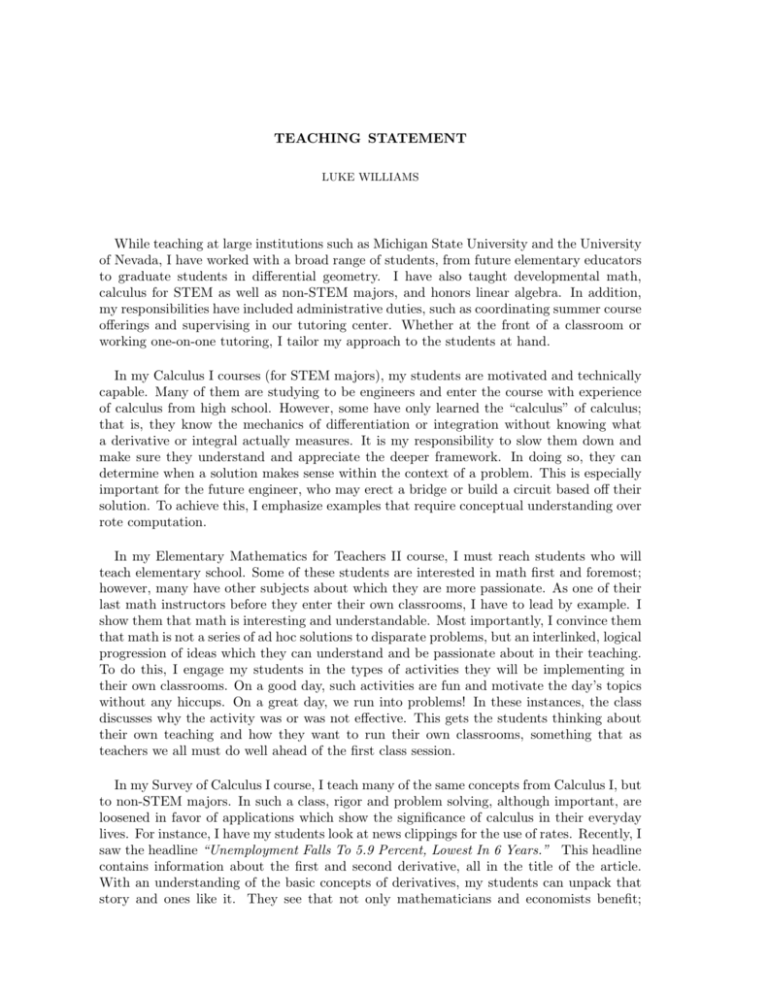
TEACHING STATEMENT LUKE WILLIAMS While teaching at large institutions such as Michigan State University and the University of Nevada, I have worked with a broad range of students, from future elementary educators to graduate students in differential geometry. I have also taught developmental math, calculus for STEM as well as non-STEM majors, and honors linear algebra. In addition, my responsibilities have included administrative duties, such as coordinating summer course offerings and supervising in our tutoring center. Whether at the front of a classroom or working one-on-one tutoring, I tailor my approach to the students at hand. In my Calculus I courses (for STEM majors), my students are motivated and technically capable. Many of them are studying to be engineers and enter the course with experience of calculus from high school. However, some have only learned the “calculus” of calculus; that is, they know the mechanics of differentiation or integration without knowing what a derivative or integral actually measures. It is my responsibility to slow them down and make sure they understand and appreciate the deeper framework. In doing so, they can determine when a solution makes sense within the context of a problem. This is especially important for the future engineer, who may erect a bridge or build a circuit based off their solution. To achieve this, I emphasize examples that require conceptual understanding over rote computation. In my Elementary Mathematics for Teachers II course, I must reach students who will teach elementary school. Some of these students are interested in math first and foremost; however, many have other subjects about which they are more passionate. As one of their last math instructors before they enter their own classrooms, I have to lead by example. I show them that math is interesting and understandable. Most importantly, I convince them that math is not a series of ad hoc solutions to disparate problems, but an interlinked, logical progression of ideas which they can understand and be passionate about in their teaching. To do this, I engage my students in the types of activities they will be implementing in their own classrooms. On a good day, such activities are fun and motivate the day’s topics without any hiccups. On a great day, we run into problems! In these instances, the class discusses why the activity was or was not effective. This gets the students thinking about their own teaching and how they want to run their own classrooms, something that as teachers we all must do well ahead of the first class session. In my Survey of Calculus I course, I teach many of the same concepts from Calculus I, but to non-STEM majors. In such a class, rigor and problem solving, although important, are loosened in favor of applications which show the significance of calculus in their everyday lives. For instance, I have my students look at news clippings for the use of rates. Recently, I saw the headline “Unemployment Falls To 5.9 Percent, Lowest In 6 Years.” This headline contains information about the first and second derivative, all in the title of the article. With an understanding of the basic concepts of derivatives, my students can unpack that story and ones like it. They see that not only mathematicians and economists benefit; LUKE WILLIAMS every trade, especially those outside of STEM, has written material which is aided by this viewpoint. I take a different, more hands-off approach when dealing with advanced majors. In upper division courses such as Honors Linear Algebra, I give definitions, state theorems and simply ask “how can we go about proving something like this?” or “why should we expect a statement like this to be true?” This builds on the research side of mathematics, toward which many students at this level are heading. Of course, when a student considers an unknown question near the research level, the only questions they can ask are “is it true or false?” and “why?” For all the joy I take in sharing the structures of mathematics with my students, there is nothing more exciting than showing them how much remains for us to uncover. With this in mind, I would like to incorporate undergraduate research projects into my teaching as well. My research area of 4-manifold theory draws on many mathematical fields including knot theory, Morse theory, abstract algebra and differential geometry. Topology is a “capstone” subject. As a topologist, I draw on all sorts of subjects to solve problems. I would like to develop projects that shed light on the beauty of differential topology while still being accessible to the undergraduate. Of these fields, the most applicable to students at nearly all levels is knot theory. Because it can be pursued through combinatorics as well as differential geometry, knot theory can provide the joy of mathematical discovery for students at nearly any level. The more advanced student, with knowledge of basic topological spaces, can also investigate questions in algebraic topology and or differential geometry. These type of interactions are the best way to advertise and guide undergraduate majors toward successful graduate work in the subject. In addition to teaching and assisting in many different courses, I have gained experience in administration by coordinating the math offerings at Michigan State for three consecutive summers. Each year, I managed thirty graduate teaching assistants, each teaching sections from the lower-division classes offered by the university, becoming familiar with the types of students taking each course as well as their respective goals and requirements. Having an overarching perspective on the undergraduate offerings as well as the types of issues that crop up when serving close to a thousand students has further helped shape my approaches to teaching. I have also supervised in Michigan State’s Mathematics Learning Center, a drop-in tutoring center that services all undergraduate math courses within the university. Last year we had over 60,000 student contacts in the center! Knowing the content of each course, how that content is covered, and the type of student in attendance helps me provide quick and effective tutoring in a drop-in setting. Through my numerous teaching experiences, I have learned to easily change gears from talking about partial differential equations with a prospective engineer to talking with a future math educator about pedagogical techniques needed to communicate geometric intuition in a sixth-grade classroom. Although I have interacted with many types of students in my various roles at the university, I always seek new opportunities to serve. I strive to teach new courses whenever possible. I also enjoy working with other instructors and the department at large, and I look forward to developing research projects with undergraduates. Knowing where my students have been lets me get them started in the learning process, and knowing where they are headed determines our route along the way. Department of Mathematics, Kansas State University, Manhattan, KS 66506

